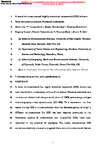A novel tri-unsaturated highly branched isoprenoid (HBI) alkene from the marine diatom Navicula salinicola
| dc.contributor.author | Gao, S | |
| dc.contributor.author | Smik, L | |
| dc.contributor.author | Kulikovskiy, M | |
| dc.contributor.author | Shkurina, N | |
| dc.contributor.author | Gusev, E | |
| dc.contributor.author | Pedentchouk, N | |
| dc.contributor.author | Mock, T | |
| dc.contributor.author | Belt, Simon | |
| dc.date.accessioned | 2020-07-09T09:15:05Z | |
| dc.date.issued | 2020-08 | |
| dc.identifier.issn | 0146-6380 | |
| dc.identifier.issn | 1873-5290 | |
| dc.identifier.other | 104050 | |
| dc.identifier.uri | http://hdl.handle.net/10026.1/15905 | |
| dc.description.abstract |
A novel tri-unsaturated C25 highly branched isoprenoid (HBI) alkene has been identified in a laboratory culture of the diatom Navicula salinicola and its structure determined using a combination of NMR spectroscopy and gas chromatography–mass spectrometry (GC–MS). This represents the first report of a C25 HBI in a marine diatom from the Navicula genus, although a different tri-unsaturated C25 HBI has been reported previously in the freshwater species N. sclesvicensis and unspecified HBIs have been identified in the brackish N. phyllepta. The newly characterised HBI contains a relatively unusual conjugated diene sub-unit, a structural feature only previously reported in some HBIs biosynthesised by a further marine diatom, Haslea ostrearia. | |
| dc.format.extent | 104050-104050 | |
| dc.language | en | |
| dc.language.iso | en | |
| dc.publisher | Elsevier BV | |
| dc.subject | Highly branched isoprenoid | |
| dc.subject | Alkene | |
| dc.subject | Diatom | |
| dc.subject | Navicula salinicola | |
| dc.title | A novel tri-unsaturated highly branched isoprenoid (HBI) alkene from the marine diatom Navicula salinicola | |
| dc.type | journal-article | |
| dc.type | Journal Article | |
| plymouth.author-url | https://www.webofscience.com/api/gateway?GWVersion=2&SrcApp=PARTNER_APP&SrcAuth=LinksAMR&KeyUT=WOS:000546214000007&DestLinkType=FullRecord&DestApp=ALL_WOS&UsrCustomerID=11bb513d99f797142bcfeffcc58ea008 | |
| plymouth.volume | 146 | |
| plymouth.publication-status | Published | |
| plymouth.journal | Organic Geochemistry | |
| dc.identifier.doi | 10.1016/j.orggeochem.2020.104050 | |
| plymouth.organisational-group | /Plymouth | |
| plymouth.organisational-group | /Plymouth/Faculty of Science and Engineering | |
| plymouth.organisational-group | /Plymouth/Faculty of Science and Engineering/School of Geography, Earth and Environmental Sciences | |
| plymouth.organisational-group | /Plymouth/REF 2021 Researchers by UoA | |
| plymouth.organisational-group | /Plymouth/REF 2021 Researchers by UoA/UoA07 Earth Systems and Environmental Sciences | |
| plymouth.organisational-group | /Plymouth/Research Groups | |
| plymouth.organisational-group | /Plymouth/Research Groups/Marine Institute | |
| plymouth.organisational-group | /Plymouth/Users by role | |
| plymouth.organisational-group | /Plymouth/Users by role/Academics | |
| plymouth.organisational-group | /Plymouth/Users by role/Researchers in ResearchFish submission | |
| dcterms.dateAccepted | 2020-05-15 | |
| dc.rights.embargodate | 2021-5-20 | |
| dc.identifier.eissn | 1873-5290 | |
| dc.rights.embargoperiod | Not known | |
| rioxxterms.versionofrecord | 10.1016/j.orggeochem.2020.104050 | |
| rioxxterms.licenseref.uri | http://www.rioxx.net/licenses/all-rights-reserved | |
| rioxxterms.licenseref.startdate | 2020-08 | |
| rioxxterms.type | Journal Article/Review |


